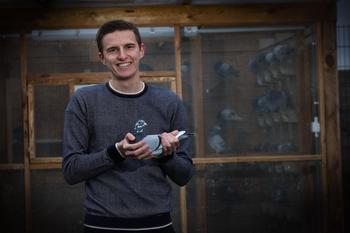
System
At the start in 2014, we immediately decided to put everything on the natural system. After reading many articles, watching films and some loft visits at top extreme long-distance fanciers, this seemed the right system for me. Apart from the fact that a lot of fanciers use it with success, there are some other advantages. When you want to race both cocks and hens, this is the least time-consuming option. The pigeons can train together and it is efficient in the space you need. You can race double the amount of pigeons on the same loft and you don’t need separate lofts for partners that aren’t raced. On the remaining part of this page, it is explained how this system is implemented at our loft.
The racing pigeons aren’t separated during the winter period. The hens and cocks are together, but the nesting boxes are closed. In addition, they are also not let out until the beginning of March. From the beginning of March they come back out sporadically. In the beginning 2 to 3 times a week, then every other day. Mid-March is invariably the time when we start darkening. The pigeons are put in the dark for 14 hours a day. The purpose of this is to be able to control the shape better and to postpone the moulting as far as possible. This is applied to the old and yearling pigeons as well as to the youngsters. In addition, the racing pigeons are separated from mid-March.
From the beginning of April we try to basket the pigeons every week, depending on the weather. Certainly in the beginning, no risks are taken and a race is sometimes skipped. When returning home, the sexes stay together until the moment of darkening. We continue to use this system for all pigeons until mid-May, the point at which the first team is coupled. From this moment on there will be a period in which a number of pigeons are coupled, but we also have pigeons in widowhood. The old pigeons are divided into 3 teams. Team 1 has Pau as a first race, team 2 will go to Agen and team 3 is prepared for Barcelona. In principle, all pigeons are basketed for the first flight on a youngster of 7-8 days, so that they are all coupled on 14 days. At the end of May, 4 weeks before the first marathon flight, it is the signal to stop darkening the pigeons.
After the pigeons have been paired, the final phase of the preparation begins. In addition to the daily training of 1.5 hours (8.30 pm to 10 pm), we try to race the pigeons once or twice on a training flight between 300 and 400 km. Since these flights in Belgian Limburg are always 2 nights basket, the weather is carefully monitored here. The pigeons are only basketed if it is almost certain that they can be released on the intended day. This is to prevent the pigeons from leaving their nest. When it is not possible to basket them for a middle distance race, a shorter race is chosen or they are taken away to Hannut (70 km). In the last week before basketing, the pigeons are no longer basketed, only tossed once or twice. This is on Thursday and Friday.
When they return from the race, the pigeons are allowed to continue their nest to get back to a good position for the next flight. The preparation for the next flight is similar to the last weeks before the first flight. The pigeons train at home and are regularly basketed on a speed flight or tossed.